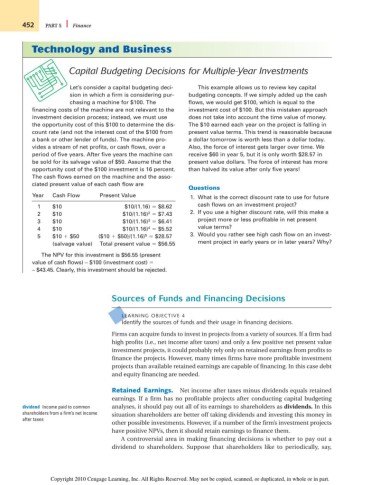Page 478 - Introduction to Business
P. 478
452 PART 5 Finance
Technology and Business
Capital Budgeting Decisions for Multiple-Year Investments
Let’s consider a capital budgeting deci- This example allows us to review key capital
sion in which a firm is considering pur- budgeting concepts. If we simply added up the cash
chasing a machine for $100. The flows, we would get $100, which is equal to the
financing costs of the machine are not relevant to the investment cost of $100. But this mistaken approach
investment decision process; instead, we must use does not take into account the time value of money.
the opportunity cost of this $100 to determine the dis- The $10 earned each year on the project is falling in
count rate (and not the interest cost of the $100 from present value terms. This trend is reasonable because
a bank or other lender of funds). The machine pro- a dollar tomorrow is worth less than a dollar today.
vides a stream of net profits, or cash flows, over a Also, the force of interest gets larger over time. We
period of five years. After five years the machine can receive $60 in year 5, but it is only worth $28.57 in
be sold for its salvage value of $50. Assume that the present value dollars. The force of interest has more
opportunity cost of the $100 investment is 16 percent. than halved its value after only five years!
The cash flows earned on the machine and the asso-
ciated present value of each cash flow are
Questions
Year Cash Flow Present Value 1. What is the correct discount rate to use for future
1 $10 $10/(1.16) $8.62 cash flows on an investment project?
2
2 $10 $10/(1.16) $7.43 2. If you use a higher discount rate, will this make a
3
3 $10 $10/(1.16) $6.41 project more or less profitable in net present
4
4 $10 $10/(1.16) $5.52 value terms?
5
5 $10 $50 ($10 $50)/(1.16) $28.57 3. Would you rather see high cash flow on an invest-
(salvage value) Total present value $56.55 ment project in early years or in later years? Why?
The NPV for this investment is $56.55 (present
value of cash flows) – $100 (investment cost)
– $43.45. Clearly, this investment should be rejected.
Sources of Funds and Financing Decisions
LEARNING OBJECTIVE 4
Identify the sources of funds and their usage in financing decisions.
Firms can acquire funds to invest in projects from a variety of sources. If a firm had
high profits (i.e., net income after taxes) and only a few positive net present value
investment projects, it could probably rely only on retained earnings from profits to
finance the projects. However, many times firms have more profitable investment
projects than available retained earnings are capable of financing. In this case debt
and equity financing are needed.
Retained Earnings. Net income after taxes minus dividends equals retained
earnings. If a firm has no profitable projects after conducting capital budgeting
dividend Income paid to common analyses, it should pay out all of its earnings to shareholders as dividends. In this
shareholders from a firm’s net income situation shareholders are better off taking dividends and investing this money in
after taxes
other possible investments. However, if a number of the firm’s investment projects
have positive NPVs, then it should retain earnings to finance them.
A controversial area in making financing decisions is whether to pay out a
dividend to shareholders. Suppose that shareholders like to periodically, say,
Copyright 2010 Cengage Learning, Inc. All Rights Reserved. May not be copied, scanned, or duplicated, in whole or in part.

